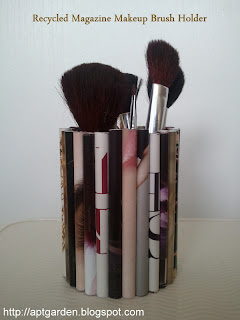Photo: Recycled Magazine Makeup Brush Holder
I finally got around to trying that recycled magazine project I blogged about earlier this year. I decided to create a makeup brush holder by using pages from my Glamour magazine to decorate a tin can. It was a lot easier than I thought, and it took me less than a couple of hours to complete this project. Continue reading to see step by step instructions on how to create this makeup brush holder.
- Scissors
- Magazines
- Ruler
- Pencil
- Tape
- Rubberband
- Tin Can (cleaned and dried)
- Elmer's Glue
- Glue Gun
Directions
- Tear out pages from your magazine that has a lot of pretty colors, prints, text and/or images.
- Measure your tin can's height. Then cut strips from magazines that are the same height. For example, my tin can was about 4.5" so I cut sheets of paper that had a height of 4.5".

- Then lay a single sheet down, and fold the rough edge of the paper about 1/4" so that you have a straight edge. Then take the pencil and roll it so that the magazine wraps around the pencil.



- Secure the tube with a small piece of tape (i.e., about 1/4" of tape). Repeat this process until you have enough tubes to surround the entire tin can.


- Wrap the rubber band around the tin can. Then slip the tubes of magazines under the rubber band to see if you like your design.


- Plug in your glue gun, and place two droplets of glue at the top and the bottom of the can (See Photo with yellow stars below). Then place the first tube down. Make sure that it is align with the bottom of the can. Then place a thin layer of glue on the side of the tube (See Photo with pink start below). Place another thin layer of glue on the tube, and then place two more droplets of glue on the can. Then secure with another tube. Repeat this process to the end. Secure with a rubber band until project dries.

































